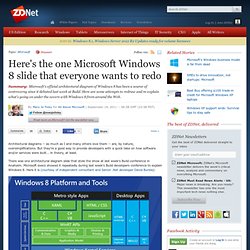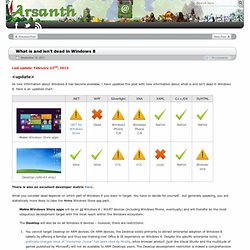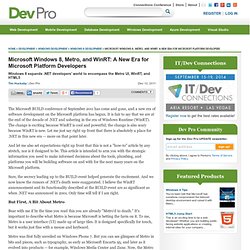

Here's the one Microsoft Windows 8 slide that everyone wants to redo. Architectural diagrams -- as much as I and many others love them -- are, by nature, oversimplifications.

But they're a good way to provide developers with a quick take on how software and/or services were built... in theory, at least. There was one architectural diagram slide that stole the show at last week's Build conference in Anaheim. Microsoft execs showed it repeatedly during last week's Build developers conference to explain Windows 8. Here it is (courtesy of independent consultant and Senior .Net developer David Burela): (click on slide to enlarge) The basic concept: Windows 8 on x86/x64 is a dual-personality operating system. Microsoft's focus at Build was almost exclusively on the Metro side of the diagram, as one would expect, given this is the "new stuff. " Since this architectural-stack slide made its debut in the Build keynote kickoff on September 12, it's been the source of a lot of much controversy and many late-night bar discussions. click on slide to enlarge)
Winrtfriday. What is and isn’t dead in Windows 8 - Arsanth. Last update: February 22nd, 2013 As new information about Windows 8 has become available, I have updated this post with new information about what is and isn’t dead in Windows 8.

Here is an updated chart: There is also an excellent developer matrix here. What you consider dead depends on which part of Windows 8 you want to target. You have to decide for yourself… but generally speaking, you are statistically more likely to take the Metro Windows Store app path. Metro Windows Store apps will be on all Windows 8 / WinRT devices (including Windows Phone, eventually) and will therefor be the most ubiquitous development target with the most reach within the Windows ecosystem. The Desktop will also be on all Windows 8 devices – however, there are restrictions: You cannot target Desktop on ARM devices. For most developers, Metro Windows Store app tooling will be more accessible, and the platform itself will offer the biggest reach. Here is the original post from September 15, 2011. WinRT Metro.NET. Microsoft Windows 8, Metro, and WinRT: A New Era for Developers.
The Microsoft BUILD conference of September 2011 has come and gone, and a new era of software development on the Microsoft platform has begun.

It is fair to say that we are at the end of the decade of .NET and ushering in the era of Windows Runtime (WinRT). The change is exciting because WinRT is cool and powerful; the change is also scary because WinRT is new. Let me just say right up front that there is absolutely a place for .NET in this new era -- more on that point later. And let me also set expectations right up front that this is not a "how-to" article by any stretch, nor is it designed to be. This article is intended to arm you with the strategic information you need to make informed decisions about the tools, plumbing, and platforms you will be building software on and with for the next many years on the Microsoft platform. Sure, the secrecy leading up to the BUILD event helped generate the excitement. But First, A Bit About Metro. Windows 8 – An OS of two halves. In this blog post I take a look at Windows 8 on the outside, from a user perspective; and on the inside, from a developer perspective to see how it will change the way we develop with Windows on tablets, smartphones and the desktop when it is released next year.

In Anaheim, California, the Microsoft //build/ conference is drawing to a close. And as the attendees head for home, with their shiny new Samsung tablets under their arms, the news of Windows 8 and the impact it has on end-users and developers is starting to sink in around the globe. There is no doubt that the impact of Windows 8 is going to be very large, it heralds the biggest change in the Windows architecture since 1993 and from an end-user perspective it is like no other version of Windows before it. So why such a radical change to both the UI and the architecture?
And why now? An end-user perspective You can run multiple applications side-by-side in a split-screen mode: On the desktop, Windows 8 does feel a bit strange.